UNUSUAL IN YOUR COLLECTIONS
From the Editor. In this issue we publish the photos of the plants from collections of Sergei Malyh (Russia), Oleg Ilyashenko (Ukraine) and Robert Hood (USA). We are very grateful to all the authors of these photos and would like to remind you dear readers that the photos from you picturing the unusual "behaviour" of the plants from your collections are always welcome.
Sergei Malyh (Chelyabinsk, Russia)
http://www.realmusic.ru/magic_key
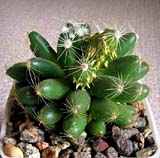 |
Photo 1.
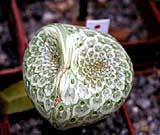 | | Photo 2.
| |
Dolichothele sphaerica SB857 (Photo 1)
This plant has been grown from seeds in March 2002. In the beginning of May 2004 there appeared roots on the tubercles of one specimen, while all the others specimens of Dolichothele sphaerica SB857 grown from the same seeds were quite ordinary and were beginning to bud. This unusual specimen grows on its own roots and has never been treated with insecticides, fungicides or other poisons. The potting mix is made of leaf mould and sand, the plant has never been fertilized yet.
Oleg Ilyashenko (Donetsk, Ukraine)
http://cactuses.nm.ru
Photo 2 shows a specimen of Euphorbia turbiniformis with a split top, grafted onto Euphorbia canariensis.
Ferobergia on Photo 3 is a result of crossing between Leuchtenbergia principis and Ferocactus acanthodes . This Ferobergia has been grafted onto Eriocereus jusbertii which then decided that it was time to flower.
Euphorbia flanaganii f. cristata is grafted onto E. сanariensis (Photo 4). The crested and the normal forms are peacefully getting along together on the same stock. It would be interesting to witness their flowers. A normal from of Euphorbia flanaganii from Albert Plapp's collection is shown here for comparison (Photo 5).

Photo 3.
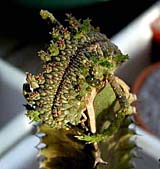
Photo 4.

Photo 5.
| | |
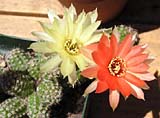 |
Photo 6.
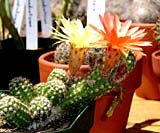 | | Photo 7.
| |
Robert Hood (California, USA)
http://www.hoodr.com/cacti/index.php
Echinopsis chamaecereus (Photo 6, 7)
Robert comments on his plant: "I bought the Echinopsis from a local nursery about a year ago. It was labeled Chamaecereus Silvestrii , and I relabeled it Echinopsis based on several sources saying its name had changed. Mostly it flowers in all yellow, with occasional hints of red.
Sometimes I get a yellow flower with an orange petal, or in one case, half an orange petal. The whole orange flower was a surprise, and neat to see alongside a whole yellow one (with a single orange petal). Cultivation environment is outside in sunny California. Gets sun half the day. Offsets rapidly."





